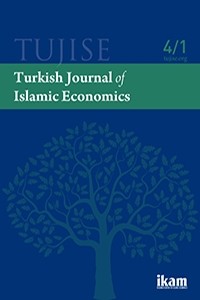Do Islamic Banking standards convey more financial transparency than conventional banking ones?
Do Islamic Banking standards convey more financial transparency than conventional banking ones?
Keywords: Islamic Banking, Transparency, Disclosure, Conventional banking, Standards AAOIFI,
___
- • AAOIFI. (2007). Shari'a standards of AAOIFI, available at : http://iefpedia.com • Aboud, S., (2009). The global financial crisis between the principle of disclosure and transparency (in arabic), presented in Third Scientific Conference, April 2009, Amman, Jordan. • Ahmed, M, U, Sabirzyanov, U & R Rosman, (2016), A critique on accounting for murabaha contract: A comparative analysis of IFRS and AAOIFI accounting standards, Journal of Islamic Accounting and Business Research, 7 (3), pp.190-201 • Akhigbe, A, McNulty, J. E, & B. A. Stevenson, Additional evidence on transparency and bank financial performance, Review of Financial Economics, 32 (1), pp.1-6 • Beck, T., Demirgüc¸ -Kunt, A., & Merrouche, O. (2013). Islamic vs conventional banking: Business model, efficiency and stability. Journal of Banking & Finance, 37 (2), pp.433-447. • Beni Salema, M., & Kand Draghma, S, S., (2014). Transparency standards in Islamic jurisprudence and its impact on crisis prevention, Journal of the Islamic University of Islamic Studies, 22 (2), pp.475-507. • Benjamin. F. (2014), “The Demand and Need for Transparency and Disclosure in Corporate Governance”, Universal Journal of Management, 2(2), pp.72-80. • Boukhris, K. & Nabi, S.M,. (2013). Islamic and conventional banks' soundness during the 2007–2008 financial crisis. Review of Financial Economics, 22(2), pp.68–77 • Bushman, R. M., (2016). Transparency, Accounting Discretion, and Bank Stability, Economic Policy Review, 22 (1), pp.129-149. • Christina, D. (2003), Transparency- Considerations for PPGIS Research and Development, URISA Journal, 15 (1), pp.73-78. • De Mendonça, H., Galvão, D., & Loures, R. .(2010)What is the importance of regulation and transparency in the subprime crisis?”. Banks and Bank Systems, 5 (1), pp.32-46. • Dridi, J. & Hasan, M., (2010). Have Islamic banks been impacted differently than conventional banks during the recent global crisis? IMF Working Paper. International Monetary Fund, Washington. • El Hamma. A. (2015). La comptabilité des produits financiers islamiques : Normes AAOIFI vs. IFRS, Revue de Management et de Stratégie, 1(2), pp.10-22. • Essaben, M. S. (1996). Studies in financial assets, measurement assets and methods of accounting, University House, Beirut, Lebanon • Gibson, C. H. (2013), Financial reporting and analysis, using financial accounting information, 13 edition, Cengage Learning, South Western, USA. • Hameed, S. (2009). Accounting and auditing for Islamic Financial Institutions, Kuala Lumpur: INCEIF, 1st Edition. • IFSB. (2016). “Islamic Financial services industry stability report, available at : http://www.ifsb.org/docs/IFSI%20Stability%20Report%202016%20(final).pdf • Kammer, A., Norat,M., Piñón, M., Prasad, A., Towe, C., Zeidane, Z & IMF Staff Team. (2015). Islamic Finance: Opportunities, Challenges, and Policy Options, IMF staff Discussion note, available at: https://www.imf.org/external/pubs/ft/sdn/2015/sdn1505.pdf. • Kane, E.J, (2009), Ethical failures in regulating and supervising the pursuit of safety-net subsidies, European Business Organization Law Review, 10, pp.185-21 • Kantakji, S, M. (2012), The Financial and accountancy Disclosure Language, Abi Al-Fida International Publishing House, distribution and translation, Hama, Syria. • Keys, B., Mukherjee, T., Seru, A. & Vig. (2009). Financial Regulation and Securitization: Evidence from Subprime Loans. Journal of Monetary Economics., 56(5), pp.700-720 • Khalil W. A. & Ashmaoui, A, M.,( 2008). Corporate governance, Freedom Library for Publishing, Egypt. • Kimura, S & H Ogawa, (2007). “A model for the convergence of accounting standards”, in Research in accounting regulation, Gary J Previts (ed), Vol 19, pp. 215-229. • Khedhery M. A. (2005). Corporate governance, Arab Nile Group, Cairo, Egypt. • Khouja E, (2013). Encyclopedia of Islamic Financial transactions : General entrance financial transactions, Al-Imtithal Islamic Finance, Tunisia. • Levy A., Rezgui H., (2013). Application des normes comptables internationales dans les banques islamiques : quel impact sur l’image fidèle de leurs états financiers ?, presented in Congrès de l'AFC, "Comptabilité sans frontières : The French Connection", 31 may and 1 june, 2013, Montréal, Canada. • Lmahfoud, S. & Tener. G (2015). La Mourabaha : principes, pratiques, controverses, Les Cahiers de la Finance Islamique. N° Spécial 2015. • Pozen, R. (2009), Too Big to Save?, John Wiley and Sons, Inc. • Stiglitz, J. E. (2009). The financial crisis of 2007/2008 and its macroeconomic consequences, Initiative for Policy Dialogue Working Paper Series, New York, available at: https:// doi.org/10.7916/D8QZ2HSG
- Başlangıç: 2014
- Yayıncı: Research Center for Islamic Economics (ikam)
Risale-i Nur’daki İslami Perspektifte Ekonomi Sosyolojisi
Methodology of Islamic Economics From Islamic Teachings to Islamic Economics
INTEREST RATE RISK IN INTEREST-FREE BANKS: AN EMPIRICAL RESEARCH ON TURKISH PARTICIPATION BANKS
Do Islamic Banking standards convey more financial transparency than conventional banking ones?
THE EFFECT OF RETAIL CREDITS ON BANK PROFITABILITY: A COMPARATIVE EMPIRICAL ANALYSIS
